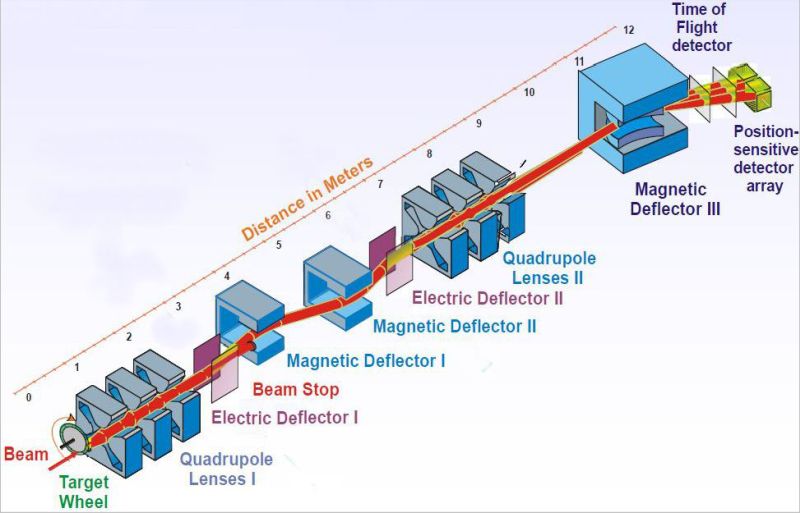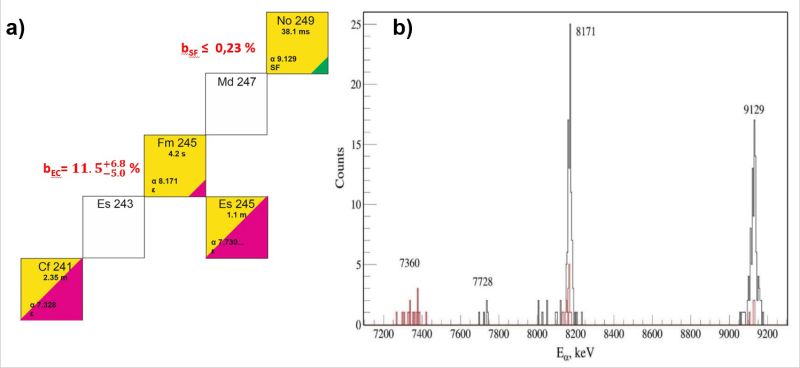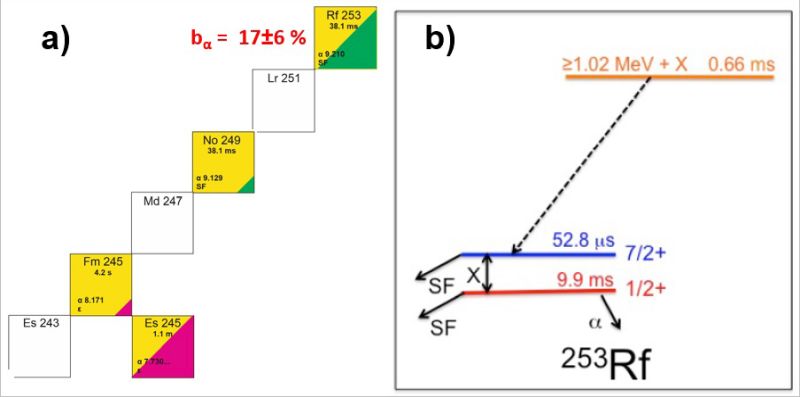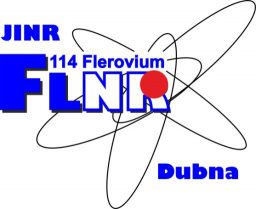FLNR scientists are the first to synthesize a new neutron-deficient isotope

Members of FLNR Sector N2 staff. From left to right: Alexander Svirikhin, Victor Chepigin, Oleg Malyshev, Alexander Yeremin, Roman Mukhin, Evgenii Sokol, Andrey Popeko, Alena Kuznetsova, Mereigul Tezekbaeva
During 2019-2021 a group of FLNR scientists studied decay properties of neutron-deficient nobelium and rutherfordium nuclei. Conducted experiments resulted in synthesis of the new neutron-deficient 249No isotope. FLNR scientists were the first in the world to synthesize it and with high statistics – 220 events.
New decay modes and isomeric states of 253Rf isotope were also discovered, α-, γ- spectra of 256No, 257Rf nuclei were analyzed and previously unknown isomeric states of these nuclei were found and the properties of spontaneously fissile 252,254No and 254Rf isotopes were studied. Derived results help scientists advance in understanding properties and limits of stability of nuclear matter.
Alexander Svirikhin, head of Sector N2 commented the results of the experiment:
256No and 257Rf
“Our group studies properties of heavy nuclei from transfermium region mainly. These works are important for understanding what the minimum and maximum neutron and proton ratio in a nucleus could be, what least number of neutrons keeps a nuclei stable. For example, in one of our experiments we reached 249No nuclei – this is the lightest No isotope discovered by us. It wasn’t easy to get this isotope nuclei: with U400 cyclotron high-intensity beams using SHELS separator of complete fusion reaction products only several tens of 249No formation events were registered which allowed to determine the scheme of its α-decay into already known nuclei. Fermium-245 into which it decays was poorly studied, we discovered a decay mode for it related to electron capture: it is capable of decaying not only into californium-241 by alpha-decay but into ensteinium-245 by electron capture. Mother nucleus – 253Rf was sinthesyzsed in the next experiment, for which decay into nobelium-249 was recorded which confirms “the right to life” of this isotope.
Gamma-spectroscopy of No and Rf nuclei
Other works of the cycle concern nucleus gamma-spectroscopy and structure. According to Alexander Svirikhin, alpha- and gamma-spectroscopy is one of the most precise ways to study nuclear forces holding together neutrons and protons in an atomic nucleus, thanks to whict one can study the fragile structure of alpha-decay, the states in which a nucleus emits gamma-quanta and nuclear isomers too.
“Fine-precision spectrometry of nuclear gamma-decay, gamma-quantum analysis is one of the powerful methods to obtain information on nuclei structure. While studying the excited states of a nucleus we draw conclusions about how neutrons and protons are grouping inside a nucleus, how this influences its stability and the state of nuclear matter in general”, – commented the scientist. This way FLNR research scientists study fundamental properties of nuclear forces – their properties are not completely discovered yet. …”
Details of the research by the scientists themselves
α-, γ-spectrometry and decay properties of 249,252,254,256No and 253,254,257Rf
In recent years on development of the experimental methods of heavy ion physics the nuclei heavier than fermium (Z ≥ 100) became available for detailed study. Characteristics of radioactive decay of heavy and superheavy nuclei produced by high-intensity beams of multiply charged ions of U400 cyclotron shed light on the properties and the limits of stability of nuclear matter. Using SHELS separator of complete fusion reaction products [1,2], Pic.1, and a wide range of detecting assemblies our group has advanced considerably in studying decay properties of nuclei of this region in recent years.

In the series of works we studied properties of radioactive decay of neutron-deficient isotopes of nobelium (No) and rutherfordium (Rf) with masses in the vicinity of neutron subshell N = 152.
For the highly neutron-deficient 249No isotope, first synthesized in SHELS separator experiment in 2020, halflife (T1/2 = 38,1±2,5 ms) and α-particle energy (Eα = 9129 keV) were measured, the probability of spontaneous fission (bSF ≤ 0,23%) was estimated, the decay scheme is given in Pic.2.

Characteristics of spontaneous fission such as TKE and instantaneous neutron yield were studied for 252,254No [4] and 254Rf [5].For 254No and 254Rf average number of neutrons per spontaneous fission was determined for the first time and amounted to 4.88 ± 0.53 and 3.87 ± 0.34, respectively. On using the improved method of statistical regularization [6], the distributions of instantaneous neutrons of spontaneous fission over multiplicities were restored. For 252No short-lived isotope the neutron yields were measured with record precision with the new SFiNX [7] detection system. The results of measurements and comparison with theoretical calculations are given in Table 1.
Table 1. Comparison of measured and calculated yields of instantaneous neutrons of spontaneous fission of nuclei recorded in the focal plane of SHELS separator.
| Nucleus | Calculated average number of neutrons per fission1 | Measured value of the average number of neutrons | Dispersion of neutron distribution over multiplicities2 |
| 254Rf | 4.7 | 3.87±0.34 | 3.4 |
| 254No | 4.6 | 4.88±0.53 | 2.0 |
| 252No | 4.3 | 4.25±0.09 | 2.2 |
| 248Cm | 3.1 | 3.13±0.01 | 1.2 |
1) Calculation in improved “breaking point” model. A.V. Andreev, Eur. Phys. J. A 30, (2006).
2) Dispersion was calculated by the method of statistical regularization, the procedure is described in work [6].
The nuclear levels of heavier isotopes of nobelium and rutherfordium, both in the ground and in isomeric states, were studied in details using GABRIELA [8] detection system. When studying the nuclear levels of 256No isotope the short-lived high-spin k-isomer state [9] which is definitely identified as one-quaziparticle neutron state (11/2-[725]) was discovered for the first time. It’s possible to trace the decrease in this state excitation energy with an increase in atomic number of N=153 isotopes. For example when studying the thin structure of 257Rf α-decay [10] the similar state was discovered at a level energy of only 75 keV above the ground state.
Finally in March 2021 our 253Rf decay experiment
confirmed that this nucleus has two low-lying spontaneously fissile states with a considerable difference in half-lives (Pic.3).

Observed [11] decay details of the 3rd high-spin k-isomeric state at excitation energy above 1 MeV made it possible to define structure of the state corresponding to 253Rf short-lived spontaneously fissile activity by comparing the noted one-quasiparticle neutron state with 7/2+[624] configuration. Besides this nucleus α-decay (bα=17±6 %) resulting in formation of the earlier obtained 249No isotope [3] was recorded for the first time. Decay chain is presented in Pic.3 (a).
Our results broaden the understanding of nuclear matter behavior in the region of neutron-deficient transfermium nuclei. Measurements of partial half-lives, decay energy and the study of heavy nuclei isomerism expand the basic information for the development of the models of nuclear structure and estimation of the boundaries of existence for nuclei. Despite the fact that the low cross-sections for the full fusion reactions significantly limit the work in this area, the SHELS separator techniques make it possible to synthesize the required nuclei in quantities sufficient for the detailed study of characteristics of radioactive decay.
The results are presented in the following publications:
- Yeremin A.V., Popeko A.G., Malyshev O.N., Isaev A.V., Kuznetsova A.A., Popov Yu.A., Svirikhin A.I., Sokol E.A., Tezekbayeva M.S., Chelnokov M.L., Chepigin V.I., Lopez-Martens A., Hauschild K., Dorvaux O., Gall B., Piot J., Antalic S., Mosat P., Tonev D., Stefanova E. “Spectroscopy of the Isotopes of Transfermium Elements in Dubna: Current Status and Prospects”, 2020, Physics of Atomic Nuclei, 83 (4), pp. 503-512.
- Chelnokov M., Kuznetsova A., Dorvaux O., Gall B., Asfari Z., Tezekbaeva M., Piot J., Antalic S. “Velocity filter SHELS: Performance and experimental results”, 2020, Nuclear Instruments and Methods in Physics Research, Section B: Beam Interactions with Materials and Atoms, 463, pp. 219-220.
- Svirikhin A.I., Yeremin A.V., Zamyatin N.I., Izosimov I.N., Isaev A.V., Kuznetsova A.A., Malyshev O.N., Mukhin R.S., Popeko A.G., Popov Y.A., Sokol E.A., Sailaubekov B., Tezekbayeva M.S., Chelnokov M.L., Chepigin V.I., Andel B., Antalic S., Bronis A., Mosat P., Gall B., Dorvaux O., Lopez-Martens A., Hauschild K. “The New 249No Isotope”, 2021, Physics of Particles and Nuclei Letters, 18 (4), pp. 445-448.
- Isaev A.V., Andreev A.V., Chelnokov M.L., Chepigin V.I., Izosimov I.N., Kuznetsova A.A., Malyshev O.N., Mukhin R.S., Popeko A.G., Popov Yu.A., Shneidman T.M., Sokol E.A., Svirikhin A.I., Tezekbayeva M.S., Yeremin A.V., Zamyatin N.I., Brionnet P., Dorvaux O., Gall B., Kessaci K., Sellam A., Hauschild K., Lopez-Martens A., Antalic S., Mosat P. “Comparative Study of Spontaneous-Fission Characteristics of 252No and 254No Isotopes”, 2021, Physics of Particles and Nuclei Letters, 18 (4), pp. 449-456.
- Svirikhin A.I., Andreev A.V., Yeremin A.V., Zamyatin N.I., Izosimov I.N., Isaev A.V., Kuznetsov A.N., Kuznetsova A.A., Malyshev O.N., Popeko A.G., Popov Y.A., Sokol E.A., Tezekbayeva M.S., Chelnokov M.L., Chepigin V.I., Schneidman T.M., Andel B., Antalic S., Bronis A., Mosat P., Gall B., Dorvaux O., Retailleau B.M., Hauschild K., Lopez-Martenz A., Chauveau P., Stefanova E., Tonev D. “Prompt Neutrons from Spontaneous 254Rf Fission”, 2019, Physics of Particles and Nuclei Letters, 16 (6), pp. 768-771.
- Mukhin R.S., Dushin V.N., Eremin A.V., Izosimov I.N., Isaev A.V., Svirikhin A.I. “Reconstruction of Spontaneous Fission Neutron Multiplicity Distribution Spectra by the Statistical Regularization Method”, 2021, Physics of Particles and Nuclei Letters, 18 (4), pp. 439-444.
- Isaev A.V., Yeremin A.V., Zamyatin N.I., Izosimov I.N., Kuznetsova A.A., Malyshev O.N., Mukhin R.S., Popeko A.G., Popov Yu.A., Sailaubekov B., Svirikhin A.I., Sokol E.A., Tezekbayeva M.S., Testov D.A., Chelnokov M.L., Chepigin V.I., Antalic S., Mosat P., Brionnet P., Gall B., Dorvaux O., Kessaci K., Sellam A., Lopez-Martens A., Hauschild K. “Study of spontaneous fission using the SFiNX system” to be published in Acta Physica Polonica B Proceedings Supplement, 14 (4), 2021.
- Chakma R., Hauschild K., Lopez-Martens A., Yeremin A.V., Malyshev O.N., Popeko A.G., Popov Yu.A., Svirikhin A.I., Chepigin V.I., Dorvaux O., Gall B., Kessaci K. “Gamma and conversion electron spectroscopy using GABRIELA”, 2020, European Physical Journal A, 56 (10), art. no. 245.
- Kessaci K., Gall B.J.P., Dorvaux O., Lopez-Martens A., Chakma R., Hauschild K., Chelnokov M.L., Chepigin V.I., Forge M., Isaev A.V., Izosimov I.N., Katrasev D.E., Kuznetsova A.A., Malyshev O.N., Mukhin R., Piot J., Popeko A.G., Popov Yu.A., Sokol E.A., Svirikhin A.I., Tezekbayev, M.S., Yeremin, A.V., «Evidence of high-k isomerism in 256No», 2021, Physical Review C, 104 (4), art. no. 044609.
- Hauschild, K., Lopez-Martens, A., Chakma, R., Dorvaux, O., Gall, B.J.P., Chelnokov, M.L., Chepigin, V.I., Isaev, A.V., Izosimov, I.N., Katrasev, D.E., Kuznetsova, A.A., Malyshev, O.N., Popeko, A.G., Popov, Yu.A., Sokol, E.N., Svirikhin, A.I., Tezekbayeva, M., Yeremin, A.V., Ackermann D., Piot J., Mosat P., Andel B. “Alpha-decay spectroscopy of 257Rf”, submitted to Eur. Phys. J. A (July 2021).
- Lopez-Martens A., Hauschild K., Svirikhin A.I., Asfari Z., Chelnokov M.L., Chepigin V.I., Dorvaux O., Forge M., Gall B.J.P., Isaev A.V., Izosimov I.N., Kessaci K., Kuznetsova A.A., Malyshev O.N., Mukhin R.S., Popeko A.G., Popov Yu.A., Sailaubekov B., Sokol E.A., Tezekbayeva M.S., Yeremin A.V. “On the fission properties of 253Rf and the stability of neutron-deficient Rf isotopes” submitted to Phys. Rev. C (Lett). (October 2021).
